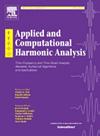频率外推的自适应乘法器
IF 3.2
2区 数学
Q1 MATHEMATICS, APPLIED
引用次数: 0
摘要
从粗尺度测量中求解物体的细节是应用数学中的一个经典问题。这个问题通常被表述为将物体的傅里叶变换从有界区域外推到整个空间,也就是说,在频率上进行外推。这个问题是不适定的,除非假设对象有一些附加结构。当目标被紧支撑时,其傅里叶变换可以扩展到整个空间。然而,众所周知,这个问题是严重病态的。在这项工作中,我们假设已知对象属于紧支持函数的集合,而不是对整个空间进行频率外推,我们研究了使用频率膨胀和单个傅里叶乘数向更大的有界集合外推的问题。这让人想起多分辨率分析中的细化方程。在适当的条件下,我们证明了在整个集合上存在一个最坏情况最优乘子,并证明了所有这些乘子具有相同的规范结构。当集合有限时,我们证明了任何最坏情况下的最优乘子都可以用厄米矩阵表示。这允许我们引入一个定点迭代来找到最优乘数。这导致我们引入一系列乘法器,我们称之为Σ-multipliers,它可以用来执行频率外推。我们建立了Σ-multipliers和多分辨率分析之间的联系。最后,我们用一些数值实验来说明我们的结果的实际意义。本文章由计算机程序翻译,如有差异,请以英文原文为准。
Adaptive multipliers for extrapolation in frequency
Resolving the details of an object from coarse-scale measurements is a classical problem in applied mathematics. This problem is usually formulated as extrapolating the Fourier transform of the object from a bounded region to the entire space, that is, in terms of performing extrapolation in frequency. This problem is ill-posed unless one assumes that the object has some additional structure. When the object is compactly supported, then it is well-known that its Fourier transform can be extended to the entire space. However, it is also well-known that this problem is severely ill-conditioned.
In this work, we assume that the object is known to belong to a collection of compactly supported functions and, instead of performing extrapolation in frequency to the entire space, we study the problem of extrapolating to a larger bounded set using dilations in frequency and a single Fourier multiplier. This is reminiscent of the refinement equation in multiresolution analysis. Under suitable conditions, we prove the existence of a worst-case optimal multiplier over the entire collection, and we show that all such multipliers share the same canonical structure. When the collection is finite, we show that any worst-case optimal multiplier can be represented in terms of an Hermitian matrix. This allows us to introduce a fixed-point iteration to find the optimal multiplier. This leads us to introduce a family of multipliers, which we call -multipliers, that can be used to perform extrapolation in frequency. We establish connections between -multipliers and multiresolution analysis. We conclude with some numerical experiments illustrating the practical consequences of our results.
求助全文
通过发布文献求助,成功后即可免费获取论文全文。
去求助
来源期刊

Applied and Computational Harmonic Analysis
物理-物理:数学物理
CiteScore
5.40
自引率
4.00%
发文量
67
审稿时长
22.9 weeks
期刊介绍:
Applied and Computational Harmonic Analysis (ACHA) is an interdisciplinary journal that publishes high-quality papers in all areas of mathematical sciences related to the applied and computational aspects of harmonic analysis, with special emphasis on innovative theoretical development, methods, and algorithms, for information processing, manipulation, understanding, and so forth. The objectives of the journal are to chronicle the important publications in the rapidly growing field of data representation and analysis, to stimulate research in relevant interdisciplinary areas, and to provide a common link among mathematical, physical, and life scientists, as well as engineers.
 求助内容:
求助内容: 应助结果提醒方式:
应助结果提醒方式:


